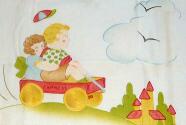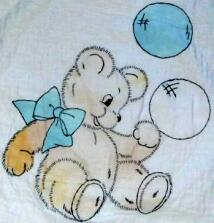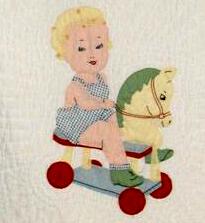HISTORY OF WOOL AND TOBACCO PREMIUM QUILTS
Judi Fibush is a quilt historian and restoration professional who developed the following presentation study on Vintage and Antique Wool and Tobacco Premium Quilts. Any comments or corrections can be sent to judi@fibush.net
Quilts come in many types and are rated pretty much from the most valuable to the lessor ones. Applique, broderie perse and whole cloth are usually considered the top of the quilting world. Then patchwork, embroidered work, kits and finally wool and tobacco premium quilts. These are the subject of my talk today. The demand for certain kinds of quilts and the prices that go with them make them the most desired.
Not too long ago wool quilts were really ignored and thought mostly utilitarian, drab and uninteresting. According to Betsy Telford, Stella Rubin, Susie Pfau, Laura Fisher and other experts and dealers, wool quilts began their revival about 2008 and are going strong. The prized ones are breath taking and very costly too. They are sought after with great demand today
Wool Quilts
Wool quilts can be generally divided into two categories: utilitarian and “fancy”.
Utilitarian wool quilts were just that. They were seldom made into a definitive design or pattern and were most likely random pieces put together in a haphazard or simulated crazy quilt fashion. They were made to be useful and heavily used. They could be sewn together from wool, flannel and even an occasional velvet, denim or cotton fabrics. The batting might have been all wool (hand carded even), cotton or in many instances many layers of previously worn clothing, blankets and even parts of old quilts too. Most homes in the cold weather areas had no central heating in the 19th and 20th centuries and some don’t even today. The quilts were bulky and not necessarily attractive but they were WARM and that was their purpose. Most were held together by densely tying and knotting yarn, heavy duty thread or string thru all layers of the body of the quilt. They served their owners well and kept all cozy thru long winter nights. Very few survived over the years due to their heavy usage and were seldom if ever cleaned and impossible to wash.
“Fancy” wool quilts on the other hand are the beauties and the “best” of the wool quilt category. They were made from fine wools such as men’s and women’s suiting fabrics, alpaca and Merino wools, gabardines and even jersey’s. Some were done in the crazy quilt style of random shaped pieces that were then overstitched with elaborate and colorful embroidery stitching. Others used may different quilt patterns that were carefully pieced. The most common designs used were the log cabin, rail fence, triangle, diamond and brick patterns.
Stumpwork (local PA name) or plushwork is a form of raised, 3-dimensional embroidery that has been around since Elizabethan times and is totally different from that which is used in some PA German wool quilts. It encompasses many fine techniques and just as many that cannot be readily categorized. Generally, it is more difficult and time-consuming.
Some quilts were batted and often only used on special or best occasions and a great deal were more decorative with no batting to show off delicate embroidery motifs and displayed in seldom used areas of the house. Most of these were never tied or quilted as they were not made for use but some were hand quilted or discretely tied to be invisible. These are the pricey favorites found today. The early Lancaster County Amish quilts are the most desired and famous and were originally made out of wool with later substitutions of rayon and cotton
Laura Fisher Quilts says “For over a century in NYC’s garment industry, for example, manufacturing had flourished in every aspect of menswear production from fabric to finished garment. Sadly today most of that industry has disappeared overseas. These suiting quilts are thus a unique legacy and a powerful link to that heritage. Wool suiting, work clothing, or military uniforms make up these darker, some nearly monochromatic, quilts. They are unfamiliar to and had been dismissed by a collecting public for whom the quilt stereotype is one fashioned from pretty calico prints.
Menswear quilts are a new discovery for collectors and, at last, are accorded respect across the globe as an indigenous textile art. These materials were typically salvage - what would be hailed as 'green' today - because they recycled waste woolens such as: suiting swatches from which the clients of tailors and fabric houses chose material for coats and pants; or cutting room remnants left from clothing manufacture; or no longer wearable family garments. Resources for the twills, tweeds, serges, gabardines and scotch plaids were outdated swatch books, or sacks of scraps from clothing construction that factories offered to workers and quilters. In some droll examples we can recognize the shape of the pants cuffs or sleeve ends that a tailor removed when shortening garments! And of course quilters used worn clothing, including even sturdy khaki from military uniforms no longer in service.
Often suiting quilts are a symphony in texture and weave rather than color contrast. While many antique “swatch” quilts were simply set in rows without any design plan that might capitalize on the scraps color variations, examples are dramatic graphic exceptions.
The menswear quilt phenomenon had a brief but historic presence in the U.S. It paralleled the emergence of the ready-made clothing industry across the country during the Industrial Revolution, and ebbed about a century later. Today because nearly all textile and clothing manufacturing operations have moved overseas, this menswear quilt style can never again reemerge here as it had proliferated from the mid-1800s through the mid- 1900s. As a result, this historic quilt bounty is newly appreciated. Transcending their utilitarian origin, thanks to their handsome palette and tonal sophistication they are a studied aesthetic with a fascinating back story.”
Woolen Mills
Here is just a brief glimpse at some of the woolen mills of old. At the height of the industry in America over 80 mills were operating from Coast to Coast.
Woolrich Woolen Mill, 1830, Plum Run, PA, operating today
Williamette Woolen Mill, 1847 became Thomas Kay Woolen Mill, Oregon 1889 which became Pendleton Woolen Mills, Washougal, WA, operating today. - The only woolen mill west of the Missouri with turbines in the Pacific Northwest that is still capable of generating electricity from the millrace.
American Woolen Company, Connecticut, 1899, operating today - AWC assimilated 8 woolen mills in MA and RI. Still in business today making men’s worsted wool for suits and cashmere and camel hair wool for coats.
Faribault Woolen Mill Co, Minnesota 1865, operating today - Still is a wool carding business and today is making blankets and woolen scarves. Went bankrupt in 2001; bought and reopened in 2012 and uses imported wools and some synthetics.
References
http://www.artfixdaily.com/artwire/release/5133-male-enhancements-suit-able-quilts
http://en.wikipedia.org/wiki/American_Woolen_Company
http://www.woolrich.com/woolrich/company/aboutUs.jsp
TOBACCO TEXTILES
Cigarette silks, a type of tobacciana, were premiums redeemable by mail order or enclosed in packages of cigarettes. Cigarette and cigar companies: OMAR, ZIRA, NEBO, EGYPTIENNE LUXORY, TURKISH TROPHIES, B.V.D (British) and Sovereign, etc. began making premiums. These premiums became popular in the early 1900s, with trading cards distributed in cigarette packages being their predecessors. Most of these small fabric pieces were sewn together to fashion larger textiles such as quilts and table covers, and some cigarette packages even included instructions for industrious homemakers to follow.
In comparison to cigar ribbon textiles, cigarette silks are harder to come by. More cigar ribbon items than cigarette silk pieces have been preserved. Given that every city in the U.S. probably had a cigar factory the logic is that these were more readily available than cigarette silk premiums which mostly were sent by mail.
FLANNELS
“Tobacco flannels are sometimes referred to as cigar felts but are really a thin cheap flannel fabric. Originally it was thought that the flannels were inserted into the boxes of cigars." But according to cigar box collector and historian Tony Hymen, there is no reason that they should be called “cigar felts”. Hymen, who is the curator of the National Cigar Box Museum, says that he has never seen a felt in the over 100,000 cigar boxes he has examined in a period of over 20 years. He challenges anyone to prove to him that these felts, or flannels, came inside cigar boxes. The popular idea that these flannels actually came in the cigar boxes may stem from the fact that paper sheets of two were misidentified with each other, and thus the flannels have been thought to come from the cigar boxes. Flannels come in a wide range of sizes, the smallest is the 3 ½ x 5 ½ inch flannel and the largest is 30”. Sometimes paper facsimiles were placed in the box of cigars.
Basic Facts
• Most of these are not ‘felts’ as they are not made of felt, but
flannel.
• The people who made and distributed them called them
‘blankets’ because the 1st patterns were Indian blankets.
• Their
correct name today is ‘flannels’ to distinguish them from satins.
•
Three patterns predominate: flags, rugs and everything else (the rarities,
i.e.: baseball figures, butterflies, kewpie dolls, wild animals,
etc.
• Thousands of variations in color, size and design exist.
• The
largest flag is 30” while the largest rug is 28 ½” long.
• Almost all
were made between 1910 and 1915.
• A few were inserted into packages of
cigarettes and small cigars.
• More often they were wrapped outside a
package, secured by a paper band.
• Most were premiums, exchanged for
coupons found in various products.
• No evidence exists they were ever
packed in cigar boxes. That’s a myth.
• Women were encouraged to make
blankets and coverlets from them.
• The dyes run easily. A single drop
of water can make one valueless.
• Dirty or damaged flannels have no
value.
SILKS/SATINS
Just after the turn of the century cigarette companies began to press their sales and by 1920 cigarette smoking had become quite common gradually including more and more women. Around the first decade of the century they began to include a small silk picture. By shifting to offering pictures on silks, companies could use the buying power of women. Women were eager to obtain these popular sets of printed silk. The quality of these "silkies" varied from brand to brand. Eventually both silk and cotton was woven together making more colorful pictures possible.
Basic Facts
Silks came in 2 styles, printed and woven and almost all were made of woven satin not silk. They came as rugs, flags and the rest were rarities in many different sizes. Most were premiums made from 1912 to 1915 and were inserted into packages and small cigars. They were primarily aimed at women smokers and to encourage them to make things from them.
These were expensive to give away, costing the American Tobacco Company more than a quarter million dollars a year in the “real money” of 1914 when a loaf of bread cost less than a dime. As a result, silks-satins-rugs were seldom associated with low price brands. People who smoked the cheaper American blends were not deprived of these colorful marvels as they were all available in sets in exchange for coupons. Larger silks could be exchanged individually for coupons.
Prices weren’t cheap. One coupon came with each 5¢ tobacco item purchased at a United Cigar Store or other retailer carrying American Tobacco brands. Five 7” x 9” satins cost 90 coupons; one 10” x 12” leather was 50. Any design given by an American Tobacco brand made by Anargyros (girls, ball players, flags, actresses, actors, college seals or mascots, generals, Indians) could be obtained through the mail as a card, satin, or leather, even behind glass with a choice of frame woods and styles.
CIGAR RIBBONS
Judy Anne Breneman – “During the late nineteenth century most men enjoyed a good cigar. Because many cigars were made and sold locally there were cigar manufacturers everywhere. With thousands of brands to choose from there was keen competition among companies to establish their name as the best.
Cigars were often sold in bundles wrapped by a silk ribbon with the brand name printed on it. These ribbons served not only the practical purpose of packaging the cigars but also as a way to attract buyers to a specific brand. Often ribbons were made with low grade silk but a few companies used fine silk with their name woven into the fabric to show that their cigars were made with a higher-grade tobacco. Women were collectors and a great way to show off a ribbon collection was to make a pillow, tablecloth or even a quilt out of the ribbons they had collected. To create these decorative items cigar ribbons were often stitched on muslin backing using fancy stitches like those used in crazy quilting.”
References
Judy Anne Breneman http://www.womenfolk.com/quilting_history/tobacco.htm
Tony Hyman http://cigarhistory.info/Premiums/Silks_and_Satins.html
http://cigarhistory.info/Premiums/Felts_and_Flannels.html
Uncoverings, Vol 21, 2000, “Better Chose Me” by Ethel Abrahams and Rachel Pannabecker



